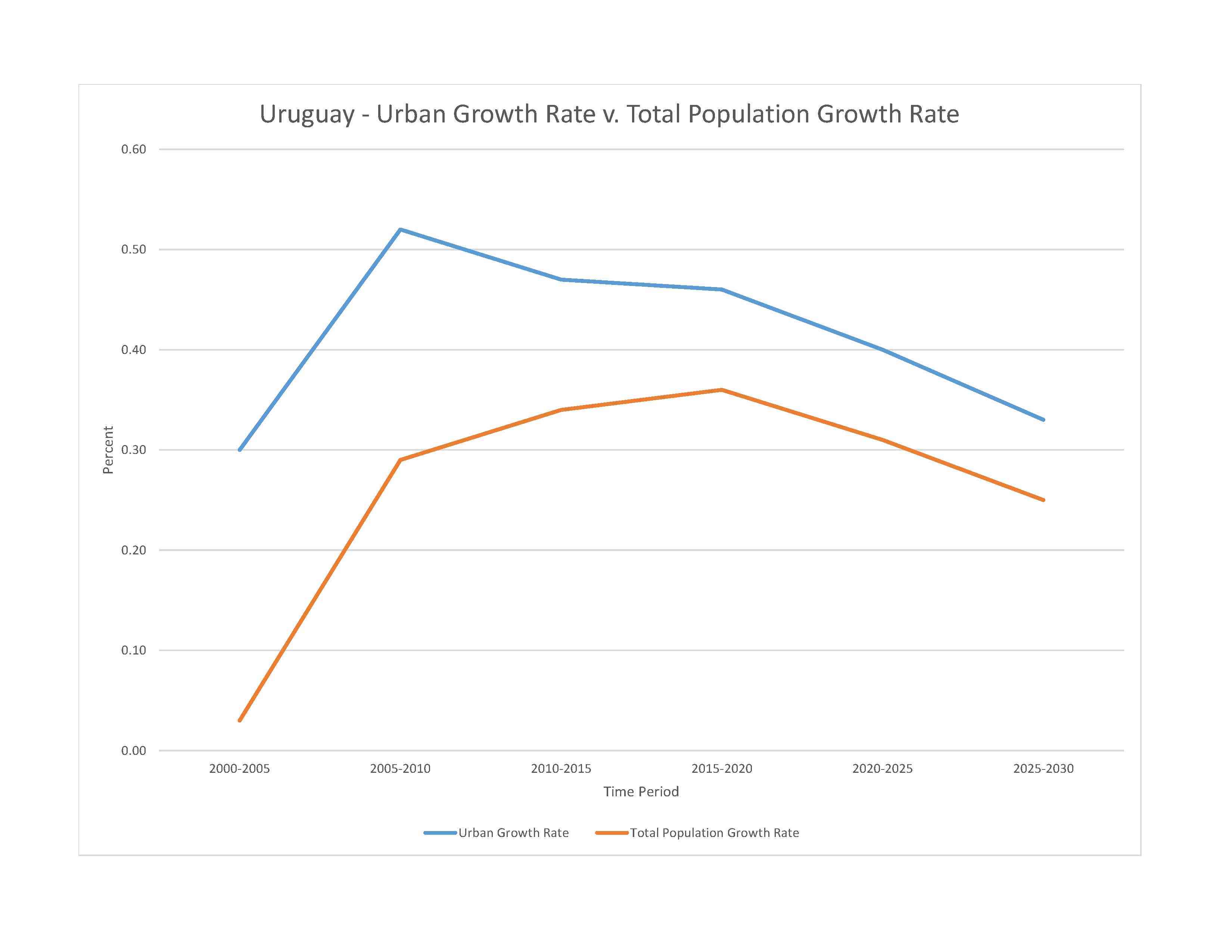
3,416,264 (2023 est.)
noun: Uruguayan(s)
adjective: Uruguayan
White 87.7%, Black 4.6%, Indigenous 2.4%, other 0.3%, none or unspecified 5% (2011 est.)
note: data represent primary ethnic identity
Spanish (official) (many speak the Rioplatense dialect)
major-language sample(s):
La Libreta Informativa del Mundo, la fuente indispensable de información básica. (Spanish)
The World Factbook, the indispensable source for basic information.
Spanish audio sample:
Roman Catholic 36.5%, Protestant 5% (Evangelical (non-specific) 4.6%, Adventist 0.2%, Protestant (non-specific) 0.3%), African American Cults/Umbanda 2.8%, Jehovah's Witness 0.6%, Church of Jesus Christ 0.2%, other 1%, Believer (not belonging to the church) 1.8%, agnostic 0.3%, atheist 1.3%, none 47.3%, unspecified 3.4%
Roman Catholic 42%, Protestant 15%, other 6%, agnostic 3%, atheist 10%, unspecified 24% (2023 est.)
Uruguay rates high for most development indicators and is known for its secularism, liberal social laws, and well-developed social security, health, and educational systems. It is one of the few countries in Latin America and the Caribbean where the entire population has access to clean water. Uruguay's provision of free primary through university education has contributed to the country's high levels of literacy and educational attainment. However, the emigration of human capital has diminished the state's return on its investment in education. Remittances from the roughly 18% of Uruguayans abroad amount to less than 1 percent of national GDP. The emigration of young adults and a low birth rate are causing Uruguay's population to age rapidly.
In the 1960s, Uruguayans for the first time emigrated en masse - primarily to Argentina and Brazil - because of economic decline and the onset of more than a decade of military dictatorship. Economic crises in the early 1980s and 2002 also triggered waves of emigration, but since 2002 more than 70% of Uruguayan emigrants have selected the US and Spain as destinations because of better job prospects. Uruguay had a tiny population upon its independence in 1828 and welcomed thousands of predominantly Italian and Spanish immigrants, but the country has not experienced large influxes of new arrivals since the aftermath of World War II. More recent immigrants include Peruvians and Arabs.
0-14 years: 19.02% (male 330,536/female 319,132)
15-64 years: 65.55% (male 1,110,881/female 1,128,546)
65 years and over: 15.43% (2023 est.) (male 213,750/female 313,419)
total dependency ratio: 53.6
youth dependency ratio: 29.9
elderly dependency ratio: 23.7
potential support ratio: 4.2 (2021 est.)
total: 36.2 years (2023 est.)
male: 34.6 years
female: 37.9 years
0.27% (2023 est.)
12.7 births/1,000 population (2023 est.)
9.1 deaths/1,000 population (2023 est.)
-0.9 migrant(s)/1,000 population (2023 est.)
most of the country's population resides in the southern half of the country; approximately 80% of the populace is urban, living in towns or cities; nearly half of the population lives in and around the capital of Montevideo
urban population: 95.8% of total population (2023)
rate of urbanization: 0.4% annual rate of change (2020-25 est.)

1.774 million MONTEVIDEO (capital) (2023)
at birth: 1.04 male(s)/female
0-14 years: 1.04 male(s)/female
15-64 years: 0.98 male(s)/female
65 years and over: 0.68 male(s)/female
total population: 0.94 male(s)/female (2023 est.)
19 deaths/100,000 live births (2020 est.)
total: 8.1 deaths/1,000 live births (2023 est.)
male: 9.3 deaths/1,000 live births
female: 7 deaths/1,000 live births
total population: 78.7 years (2023 est.)
male: 75.6 years
female: 81.9 years
1.75 children born/woman (2023 est.)
0.86 (2023 est.)
79.6% (2015)
note: percent of women aged 15-44
improved: urban: 100% of population
rural: 100% of population
total: 100% of population
unimproved: urban: 0% of population
rural: 0% of population
total: 0% of population (2020 est.)
9.2% of GDP (2020)
4.94 physicians/1,000 population (2017)
2.4 beds/1,000 population (2017)
improved: urban: 99.2% of population
rural: 99.6% of population
total: 99.2% of population
unimproved: urban: 0.8% of population
rural: 0.4% of population
total: 0.8% of population (2020 est.)
27.9% (2016)
total: 5.42 liters of pure alcohol (2019 est.)
beer: 1.86 liters of pure alcohol (2019 est.)
wine: 2.86 liters of pure alcohol (2019 est.)
spirits: 0.71 liters of pure alcohol (2019 est.)
other alcohols: 0 liters of pure alcohol (2019 est.)
total: 21.5% (2020 est.)
male: 24.4% (2020 est.)
female: 18.5% (2020 est.)
1.8% (2018)
55.4% (2023 est.)
4.6% of GDP (2020 est.)
definition: age 15 and over can read and write
total population: 98.8%
male: 98.5%
female: 99% (2019)
total: 19 years
male: 17 years
female: 20 years (2019)
NOTE: The information regarding Uruguay on this page is re-published from the 2024 World Fact Book of the United States Central Intelligence Agency and other sources. No claims are made regarding the accuracy of Uruguay 2024 information contained here. All suggestions for corrections of any errors about Uruguay 2024 should be addressed to the CIA or the source cited on each page.
This page was last modified 04 May 24, Copyright © 2024 ITA all rights reserved.